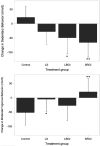Imagine HEALTH: Randomized Controlled Trial of a Guided Imagery Lifestyle Intervention to Improve Obesity-Related Lifestyle Behaviors in Predominantly Latinx Adolescents
- PMID: 34037459
- PMCID: PMC8558072
- DOI: 10.1089/acm.2020.0515
Imagine HEALTH: Randomized Controlled Trial of a Guided Imagery Lifestyle Intervention to Improve Obesity-Related Lifestyle Behaviors in Predominantly Latinx Adolescents
Abstract
Introduction: To determine the effects of a novel lifestyle intervention combining lifestyle behavioral education with the complementary-integrative health modality of guided imagery (GI) on dietary and physical activity behaviors in adolescents. The primary aim of this study was to determine the incremental effects of the lifestyle education, stress reduction GI (SRGI), and lifestyle behavior GI (LBGI) components of the intervention on the primary outcome of physical activity lifestyle behaviors (sedentary behavior, light, moderate, and vigorous physical activity), as well as dietary intake behaviors, at the completion of the 12-week intervention. The authors hypothesized that the intervention would improve obesity-related lifestyle behaviors. Materials and Methods: Two hundred and thirty-two adolescent participants (aged 14-17 years, sophomore or junior year of high school) were cluster randomized by school into one of four intervention arms: nonintervention Control (C), Lifestyle education (LS), SRGI, and LBGI. After-school intervention sessions were held two (LS) or three (SRGI, LBGI) times weekly for 12 weeks. Physical activity (accelerometry) and dietary intake (multiple diet recalls) outcomes were assessed pre- and postintervention. Primary analysis: intention-to-treat (ITT) mixed-effects modeling with diagonal covariance matrices; secondary analysis: ad hoc subgroup sensitivity analysis using only those participants adherent to protocol. Results: ITT analysis showed that the Healthy Eating Index (HEI) increased in the LS group compared with C (p = 0.02), but there was no additional effect of GI. Among adherent participants, sedentary behavior was decreased stepwise relative to C in SRGI (d = -0.73, p = 0.004) > LBGI (d = -0.59, p = 0.04) > LS (d = -0.41, p = 0.07), and moderate + vigorous physical activity was increased in SRGI (d = 0.58, p = 0.001). Among adherent participants, the HEI was increased in LS and SRGI, and glycemic index reduced in LBGI. Conclusions: While ITT analysis was negative, among adherent participants, the Imagine HEALTH lifestyle intervention improved eating habits, reduced sedentary activity, and increased physical activity, suggesting that GI may amplify the role of lifestyle education alone for some key outcomes. Clinical Trials.gov ID: NCT02088294.
Keywords: Latino; adolescents; guided imagery; lifestyle intervention; obesity; stress reduction.
Conflict of interest statement
No competing financial interests exist.
Figures


References
-
- Goran MI, Bergman RN, Avila Q, et al. . Impaired glucose tolerance and reduced beta-cell function in overweight Latino children with a positive family history for type 2 diabetes. J Clin Endocrinol Metab 2004;89:207–212. - PubMed
-
- Weigensberg MJ, Ball GD, Shaibi GQ, et al. . Decreased beta-cell function in overweight Latino children with impaired fasting glucose. Diabetes Care 2005;28:2519–2524. - PubMed
-
- Cruz ML, Shaibi GQ, Weigensberg MJ, et al. . Pediatric obesity and insulin resistance: Chronic disease risk and implications for treatment and prevention beyond body weight modification. Annu Rev Nutr 2005;25:435–468. - PubMed
Publication types
MeSH terms
Associated data
Grants and funding
LinkOut - more resources
Full Text Sources
Other Literature Sources
Medical

